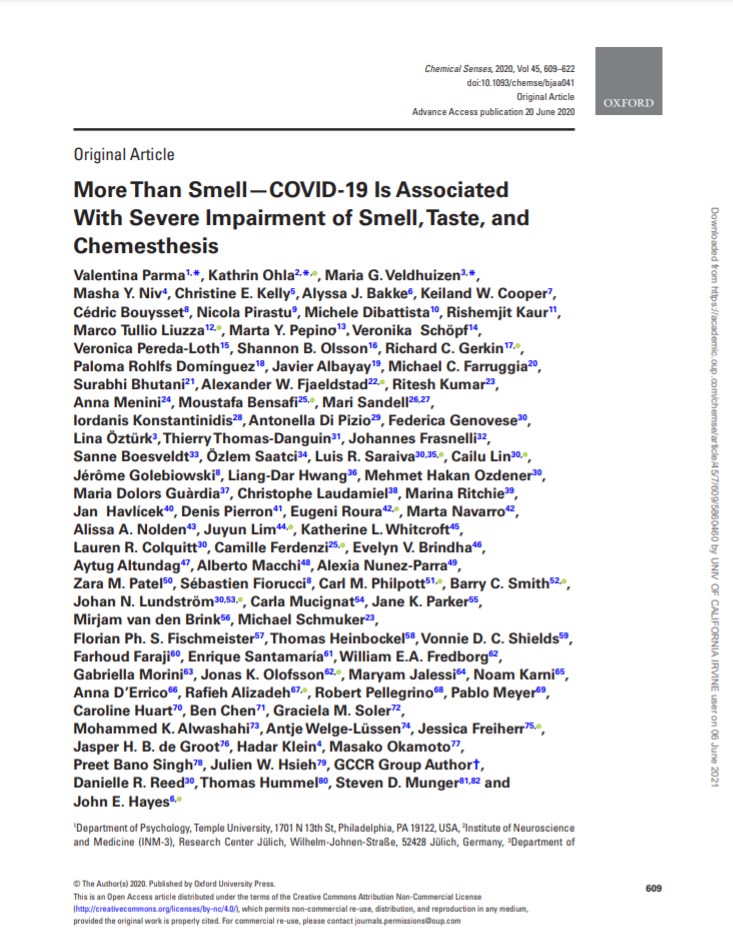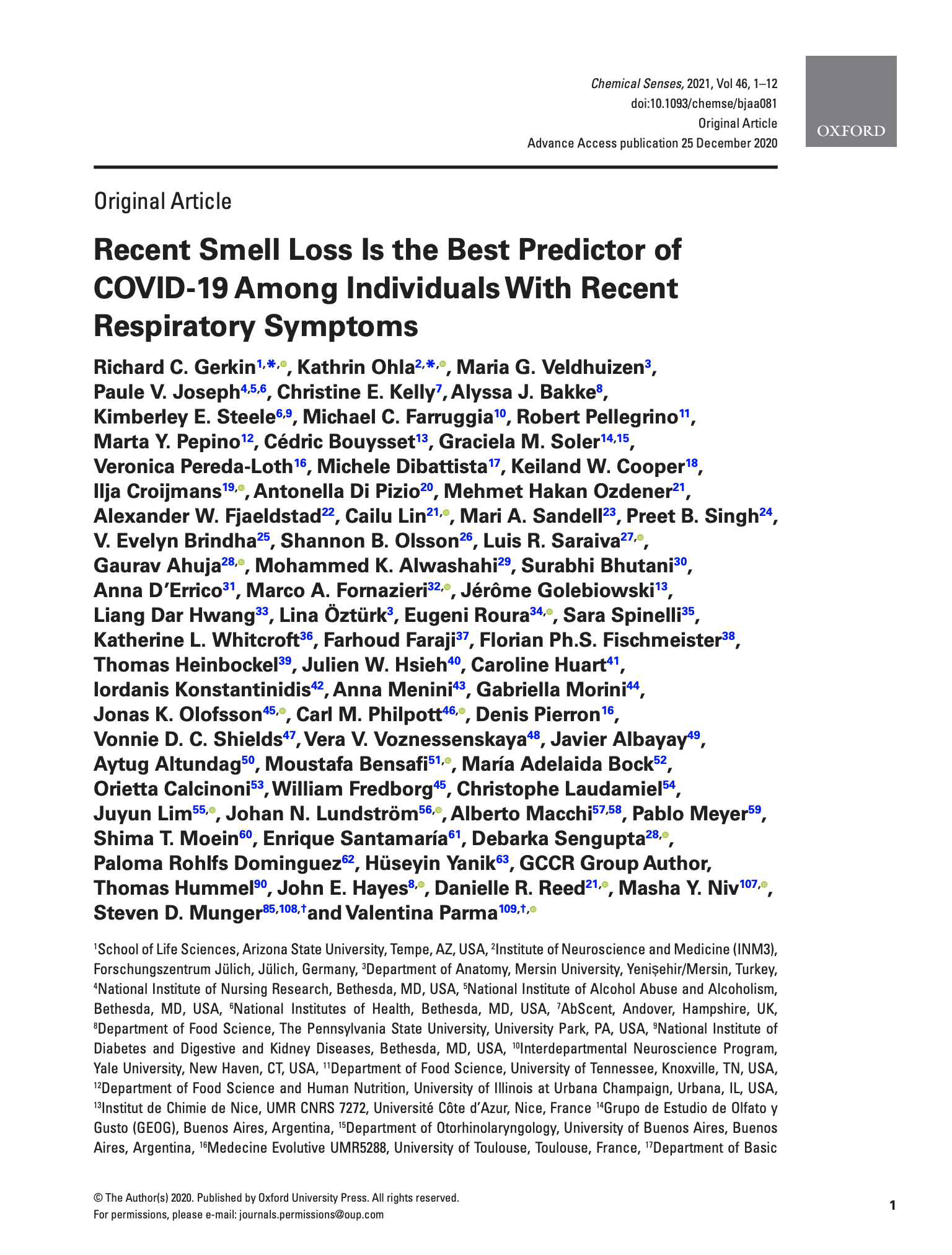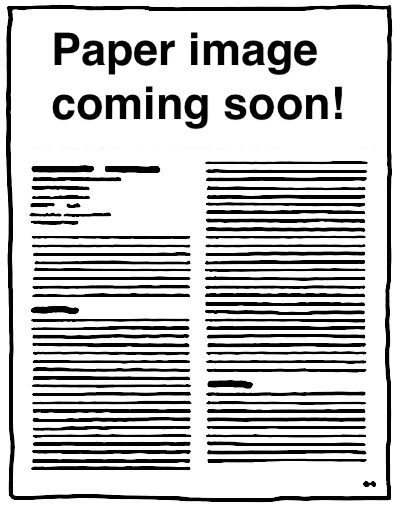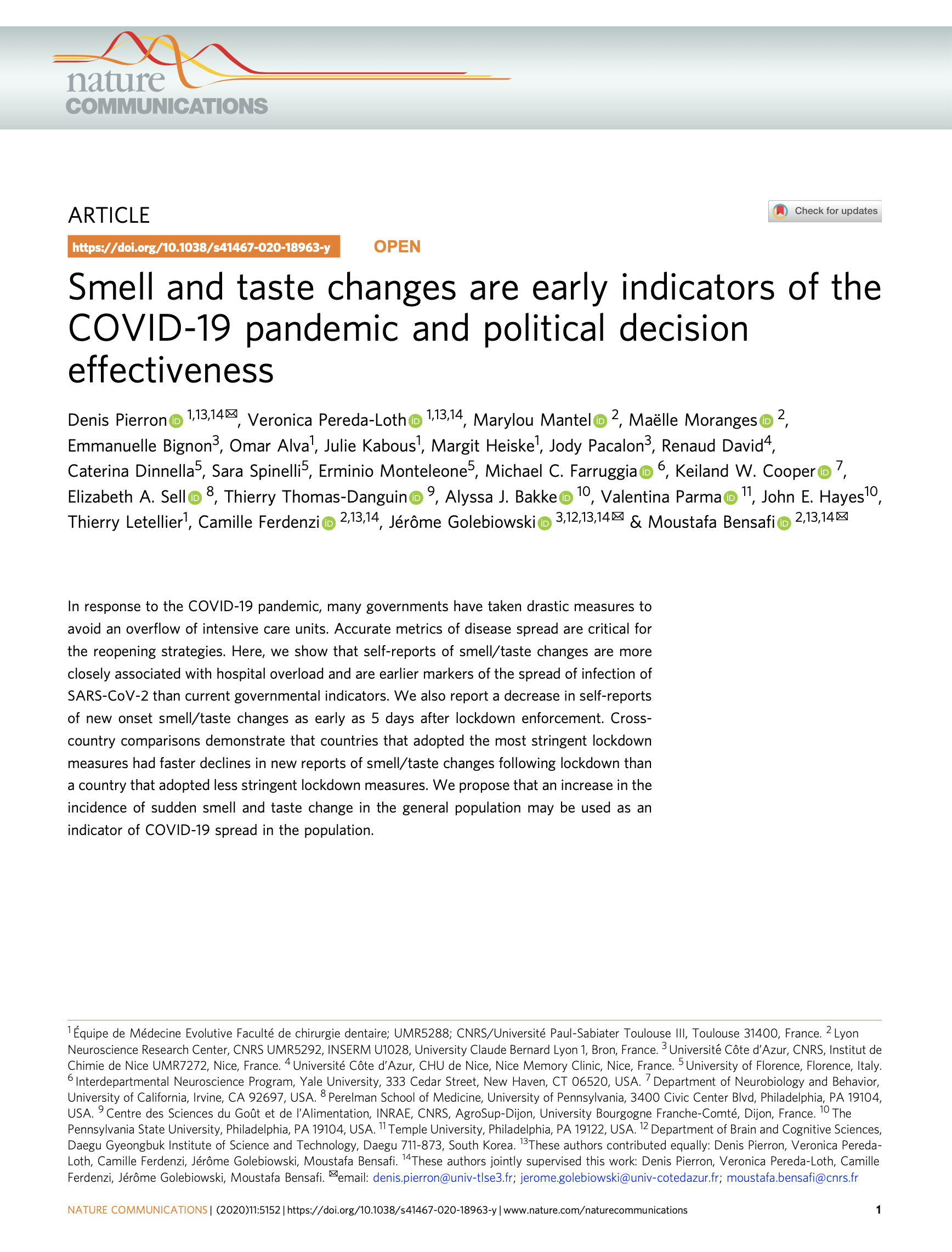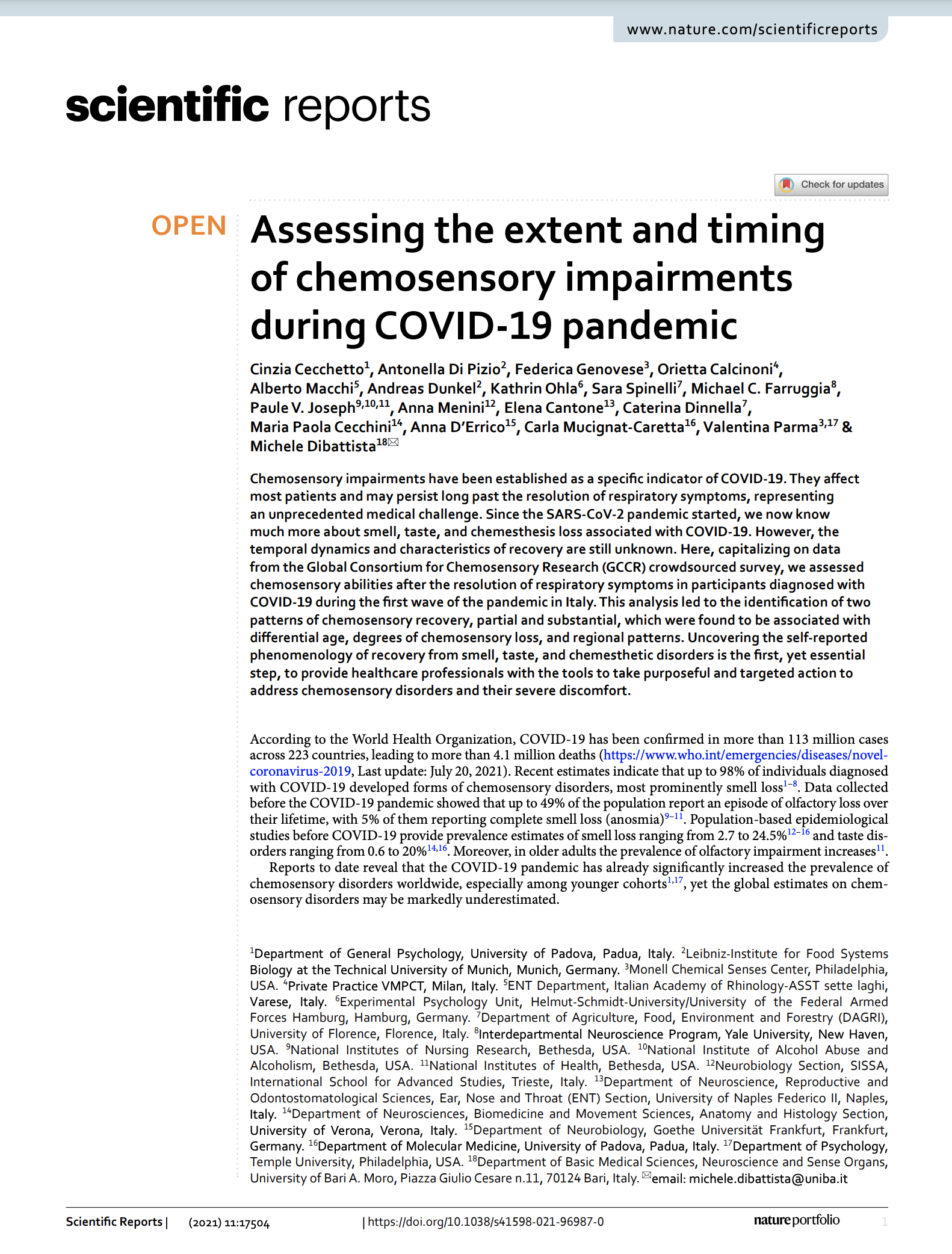GCCR Publications
More Than Smell—COVID-19 Is Associated With Severe Impairment of Smell, Taste, and Chemesthesis
2020 Chemical Senses
Context and purpose of the study:
Studies have shown that smell, taste, and chemesthesis, which is the ability to sense burning, cooling, or tingling sensations in the nose and mouth, can be affected by COVID-19 infection. However, these changes have not been studied thoroughly. Changes in smell and taste can result in complete loss or reduced ability to smell or taste things. These are called quantitative changes. Changes in smell or taste can also be distortions of smell and taste where things smell or taste altered or smells or tastes are detected when they are not present. These are called qualitative changes. Scientists in the global consortium for chemosensory research (GCCR) developed a questionnaire for COVID-19 patients and surveyed 4039 people who were diagnosed with COVID-19 either with a lab test or by a clinical assessment with a medical professional. The study was released online in 27 languages in April 2019. The survey was answered by people from all over the world. The survey looked to answer two key questions:
[1] What changes in smell, taste, or chemesthesis did people with COVID-19 experience during illness versus before illness?
[2] Were there differences in these smell, taste, or taste sensation changes between those diagnosed with COVID-19 by a lab test and those diagnosed by clinical assessment with a medical professional?
What the researchers found:
Participants reported a large loss of sense of smell and taste during COVID-19 versus before COVID-19. This large reduction of sense of smell and taste happened in those diagnosed by lab test and those diagnosed by clinical assessment with a medical professional. Loss of ability to sense chemesthesis was reported. This was similar for both the group diagnosed by lab test and diagnosed by clinical assessment. Distortions of the sense of smell (parosmia) was not reported by many participants, likely because they had recently developed a smell disorder, and did not differ between those tested by lab test and those tested by clinical assessment.
Conclusion of the paper and implications:
The majority of participants reported reduced ability to smell during COVID-19 versus before. This smell loss was not because of nasal obstruction based on participants self-reports. The results of this study suggest that COVID-19 significantly impacts smell, taste, and taste sensation function and that changes in these could predict whether someone is COVID-19 positive.
More details on how the study was done (methods, reasons of the experimental design):
The questionnaire asked participants in the study to rate their ability to smell, taste, and experience cooling, tingling, and burning sensations (chemesthesis) on a scale from 1 to 100. Participants were also asked to rate their nasal blockage from 1 to 100 with 1 being “not at all blocked” and 100 being “completely blocked”. Each section of the questionnaire was separate and stated before hand whether the questions were about smell, taste, or chemesthesis. Participation in the study was completely online and participants were not paid. To be included in the study participants needed to consent to participate, be 19 years old or older, have a form of or suspicion of respiratory illness in the past 2 weeks.
Written by: Evan Guerra
Recent anecdotal and scientific reports have provided evidence of a link between COVID-19 and chemosensory impairments, such as anosmia. However, these reports have downplayed or failed to distinguish potential effects on taste, ignored chemesthesis, and generally lacked quantitative measurements. Here, we report the development, implementation, and initial results of a multilingual, international questionnaire to assess self-reported quantity and quality of perception in 3 distinct chemosensory modalities (smell, taste, and chemesthesis) before and during COVID-19. In the first 11 days after questionnaire launch, 4039 participants (2913 women, 1118 men, and 8 others, aged 19–79) reported a COVID-19 diagnosis either via laboratory tests or clinical assessment. Importantly, smell, taste, and chemesthetic function were each significantly reduced compared to their status before the disease. Difference scores (maximum possible change ±100) revealed a mean reduction of smell (−79.7 ± 28.7, mean ± standard deviation), taste (−69.0 ± 32.6), and chemesthetic (−37.3 ± 36.2) function during COVID-19. Qualitative changes in olfactory ability (parosmia and phantosmia) were relatively rare and correlated with smell loss. Importantly, perceived nasal obstruction did not account for smell loss. Furthermore, chemosensory impairments were similar between participants in the laboratory test and clinical assessment groups. These results show that COVID-19-associated chemosensory impairment is not limited to smell but also affects taste and chemesthesis. The multimodal impact of COVID-19 and the lack of perceived nasal obstruction suggest that severe acute respiratory syndrome coronavirus strain 2 (SARS-CoV-2) infection may disrupt sensory-neural mechanisms.
Data and code avaliable here
Recent Smell Loss Is the Best Predictor of COVID-19 Among Individuals With Recent Respiratory Symptoms
2020 Chemical Senses
Context and purpose of the study:
COVID-19 infection often comes with symptoms that are also often seen in other viral illnesses, like fatigue, headache and coughing. Studies have shown that smell, taste, and other sensations like burning, cooling, or tingling sensations in the nose and mouth are also often reported in COVID-19 infection. Some studies show that smell and/or taste loss are the most usual symptom. The change that patients report is generally large. Can information about the degree of loss in smell or taste ability help tell us how likely it is that someone has COVID-19 rather than another similar illness, like the flu?
What the researchers found:
Participants with a positive COVID-19 lab test reported a larger loss of sense of smell and taste than participants with a negative test. Compared to other symptoms, we find that the knowing about the degree of smell loss allows the most accurate prediction about whether someone has COVID-19 rather than the flu. Taking more symptoms into the picture does not add much information. When patients report that their ability to smell is under 20% of the full range, the odds of them having COVID-19 are about 4 to 10 times as high.
Conclusion of the paper and implications:
The amount of smell loss is the best predictor for having COVID-19, more so that any other common symptom or combination of symptoms. Further studies are necessary, but this is the first step in establishing a quick screening tool for clinicians and contact tracers to use when lab tests are impractical or unavailable. Similar to the familiar question to “rate your pain from 0-10” your doctor might ask you to “rate your smell loss from 0-10” when they suspect COVID-19 infection.
More details on how the study was done (methods, reasons of the experimental design):
Scientists in the global consortium for chemosensory research (GCCR) developed a questionnaire for patients with respiratory illness and surveyed 4148 people who were diagnosed with COVID-19 with a lab test and 546 people who tested negative for COVID-19. The study was released online in 23 languages in April 2019. The survey was answered by people from all over the world. The questionnaire asked participants in the study to rate their ability to smell, taste, and experience cooling, tingling, and burning sensations (chemesthesis) on a scale from 1 to 100. Participants were also asked to report whether or not they experienced any of the other common symptoms of COVID-19. Participation in the study was completely online and participants were not paid. To be included in the study participants needed to consent to participate, be 19 years old or older, have a form of or suspicion of respiratory illness in the past 2 weeks.
In a preregistered, cross-sectional study, we investigated whether olfactory loss is a reliable predictor of COVID-19 using a crowdsourced questionnaire in 23 languages to assess symptoms in individuals self-reporting recent respiratory illness. We quantified changes in chemosensory abilities during the course of the respiratory illness using 0–100 visual analog scales (VAS) for participants reporting a positive (C19+; n = 4148) or negative (C19−; n = 546) COVID-19 laboratory test outcome. Logistic regression models identified univariate and multivariate predictors of COVID-19 status and post-COVID-19 olfactory recovery. Both C19+ and C19− groups exhibited smell loss, but it was significantly larger in C19+ participants (mean ± SD, C19+: −82.5 ± 27.2 points; C19−: −59.8 ± 37.7). Smell loss during illness was the best predictor of COVID-19 in both univariate and multivariate models (ROC AUC = 0.72). Additional variables provide negligible model improvement. VAS ratings of smell loss were more predictive than binary chemosensory yes/no-questions or other cardinal symptoms (e.g., fever). Olfactory recovery within 40 days of respiratory symptom onset was reported for ~50% of participants and was best predicted by time since respiratory symptom onset. We find that quantified smell loss is the best predictor of COVID-19 amongst those with symptoms of respiratory illness. To aid clinicians and contact tracers in identifying individuals with a high likelihood of having COVID-19, we propose a novel 0–10 scale to screen for recent olfactory loss, the ODoR-19. We find that numeric ratings ≤2 indicate high odds of symptomatic COVID-19 (4 < OR < 10). Once independently validated, this tool could be deployed when viral lab tests are impractical or unavailable.
Data and code avaliable here
A follow-up on quantitative and qualitative olfactory dysfunction and other symptoms in patients recovering from COVID-19 smell loss
2022 Rhinology
Comming soon!
Background: Sudden smell loss is a specific early symptom of COVID-19, which, prior to the emergence of Omicron, had estimated prevalence of ~40% to 75%. Chemosensory impairments affect physical and mental health, and dietary behavior. Thus, it is critical to understand the rate and time course of smell recovery. The aim of this cohort study was to characterize smell function and recovery up to 11 months post COVID-19 infection. Methods: This longitudinal survey of individuals suffering COVID-19-related smell loss assessed disease symptoms and gustatory and olfactory function. Participants (n=12,313) who completed an initial survey (S1) about respiratory symptoms, chemosensory function and COVID-19 diagnosis between April and September 2020, were invited to complete a follow-up survey (S2). Between September 2020 and February 2021, 27.5% participants responded (n=3,386), with 1,468 being diagnosed with COVID-19 and suffering co-occurring smell and taste loss at the beginning of their illness. Results: At follow-up (median time since COVID-19 onset ~200 days), ~60% of women and ~48% of men reported less than 80% of their pre-illness smell ability. Taste typically recovered faster than smell, and taste loss rarely persisted if smell recovered. Prevalence of parosmia and phantosmia was ~10% of participants in S1 and increased substantially in S2: ~47% for parosmia and ~25% for phantosmia. Persistent smell impairment was associated with more symptoms overall, suggesting it may be a key marker of long-COVID illness. The ability to smell during COVID-19 was rated slightly lower by those who did not eventually recover their pre-illness ability to smell at S2. Conclusions: While smell ability improves for many individuals who lost it during acute COVID-19, the prevalence of parosmia and phantosmia increases substantially over time. Olfactory dysfunction is associated with broader persistent symptoms of COVID-19, and may last for many months following acute COVID-19. Taste loss in the absence of smell loss is rare. Persistent qualitative smell symptoms are emerging as common long-term sequelae; more research into treatment options is strongly warranted given that even conservative estimates suggest millions of individuals may experience parosmia following COVID-19. Healthcare providers worldwide need to be prepared to treat post COVID-19 secondary effects on physical and mental health.
Data and code avaliable here
Smell and taste changes are early indicators of the COVID-19 pandemic and political decision effectiveness
2020 Nature Communications
Comming soon!
In response to the COVID-19 pandemic, many governments have taken drastic measures to avoid an overflow of intensive care units. Accurate metrics of disease spread are critical for the reopening strategies. Here, we show that self-reports of smell/taste changes are more closely associated with hospital overload and are earlier markers of the spread of infection of SARS-CoV-2 than current governmental indicators. We also report a decrease in self-reports of new onset smell/taste changes as early as 5 days after lockdown enforcement. Cross-country comparisons demonstrate that countries that adopted the most stringent lockdown measures had faster declines in new reports of smell/taste changes following lockdown than a country that adopted less stringent lockdown measures. We propose that an increase in the incidence of sudden smell and taste change in the general population may be used as an indicator of COVID-19 spread in the population.
Data and code avaliable here
Assessing the extent and timing of chemosensory impairments during COVID-19 pandemic
2021 Scientific Reports
Comming soon!
Chemosensory impairments have been established as a specific indicator of COVID-19. They affect most patients and may persist long past the resolution of respiratory symptoms, representing an unprecedented medical challenge. Since the SARS-CoV-2 pandemic started, we now know much more about smell, taste, and chemesthesis loss associated with COVID-19. However, the temporal dynamics and characteristics of recovery are still unknown. Here, capitalizing on data from the Global Consortium for Chemosensory Research (GCCR) crowdsourced survey, we assessed chemosensory abilities after the resolution of respiratory symptoms in participants diagnosed with COVID-19 during the first wave of the pandemic in Italy. This analysis led to the identification of two patterns of chemosensory recovery, partial and substantial, which were found to be associated with differential age, degrees of chemosensory loss, and regional patterns. Uncovering the self-reported phenomenology of recovery from smell, taste, and chemesthetic disorders is the first, yet essential step, to provide healthcare professionals with the tools to take purposeful and targeted action to address chemosensory disorders and their severe discomfort.
Data and code avaliable here
